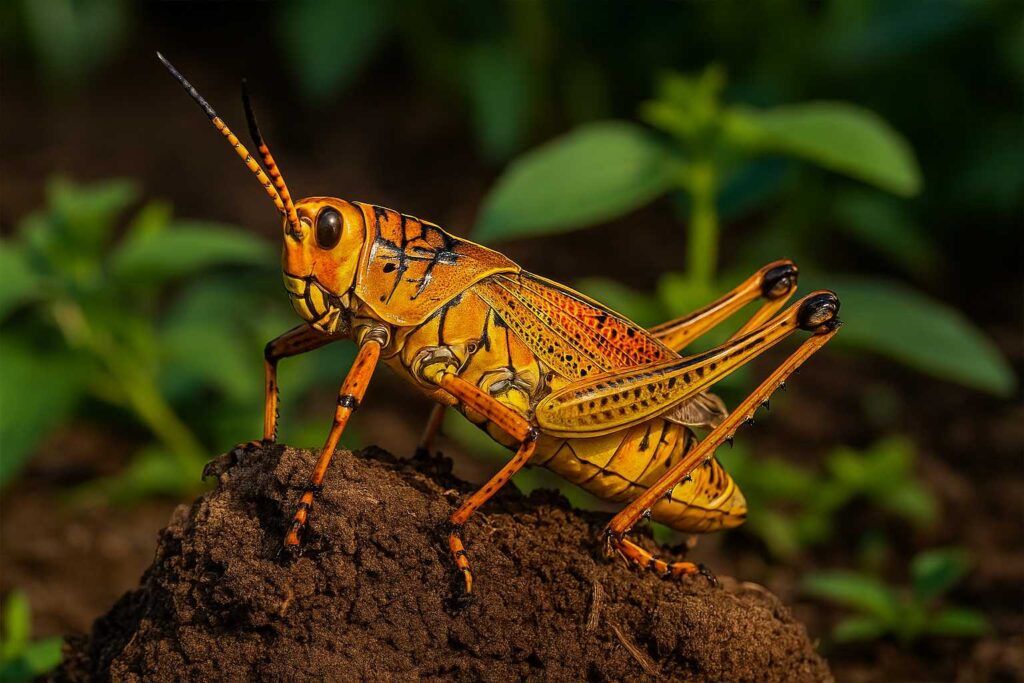 It’s big. It’s bold. And it’s bad news for your garden.
It’s big. It’s bold. And it’s bad news for your garden.
If you’ve been in Central Florida during the warmer months, chances are you’ve crossed paths with the Eastern Lubber Grasshopper (Romalea microptera). These vibrant yellow, orange, and black grasshoppers can grow up to 3 inches long, making them one of the largest grasshopper species in North America—and certainly one of the most visible.
But behind their almost comical appearance lies a serious threat to home gardens and native vegetation.
Why Are They So Hard to Miss?
Lubbers are not subtle. Their bright colors act as a warning to predators: Don’t eat me—I taste awful. And it’s true. When threatened, lubbers release a foul-smelling foamy secretion from their body and hiss. Birds and small mammals quickly learn to leave them alone.
That’s part of what makes lubbers such a nuisance: they have few natural predators.
What Do Lubbers Eat?
Unfortunately, almost everything. While they prefer soft, leafy greens like amaryllis, daylilies, and crinum lilies, lubbers will sample herbs, vegetables, and even toxic plants with little hesitation. Unlike some pests, they’re not picky.
Once hatched in spring, nymphs (baby lubbers) cluster in groups and feast communally. By mid-summer, they mature into adults—and their appetites grow even larger.
What Can You Do? (Without Reaching for the Chemicals)
Lubber control is challenging, especially if you’re aiming for an organic or pollinator-friendly garden. Here’s how you can manage them naturally:
1. Hand-pick Early and Often
The best time to stop an infestation is when they’re still small and flightless. Nymphs are black with a red stripe and tend to cluster—making them easier to spot and squish. Gloves recommended.
2. Chickens to the Rescue
If you keep backyard chickens, you’re in luck. While most wildlife avoids lubbers, chickens have no such qualms and will happily gobble them up.
3. Barrier Methods
If your garden is under siege, try floating row covers or fine mesh netting around prized plants.
4. Use Targeted Traps
Although lubbers can’t fly well, they hop high. Create shallow containers with soapy water and bait (like lettuce) to trap them if infestations are dense.
5. Let Your Neighbors Know
Lubbers often wander from neglected lots or yards. Community awareness can help reduce their population over time.
Fun Facts for Nature Lovers
They can’t really fly. Despite having wings, lubbers are heavy-bodied and rely mostly on walking or hopping.
They’re native. Eastern lubbers are part of Florida’s natural ecosystem, though in urban areas they’ve become invasive-like due to a lack of predators.
They’re ancient. Fossil records suggest lubbers and their kin have been around for millions of years!
Peak Season in Florida
Expect to see lubber nymphs emerge in March–April, with adults roaming by June–August. They typically complete one life cycle per year but do plenty of damage during that time.
Final Thoughts
The Eastern Lubber Grasshopper may be beautiful, but don’t be fooled—it’s a formidable garden pest. With some timely intervention and a little neighborhood coordination, you can keep these bold bugs in check.
Have you spotted a lubber in your garden this summer? Share your photo or solution in the comments!
